Related Research Articles
The music of World War I is the music which was composed during the war or which is associated with the war.
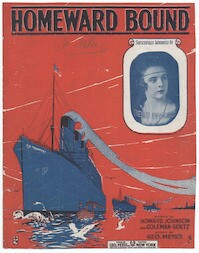
Homeward Bound is a World War I era song that says the war will soon be over, and the soldiers will be able to return home. It has a hopeful message and was meant to comfort both soldiers and the family and friends of soldiers. It was composed by George W. Meyer, written by Howard Johnson and Coleman Goetz, and produced by Leo. Feist, Inc. in 1917.

"Yankee Boy" is a World War I song. Lyrics were written by Fred Ziemer, and music was composed by J.R. Shannon. Vandersloot Music Publishing Company produced the song in 1918. On the cover of the sheet music, there is a soldier in a trench, throwing a grenade. The song was written for both voice and piano. The lyrics show support for the soldiers fighting in the war, and how the Yankee Boy will "win both fame and glory."

I'm Going to Follow the Boys (Novelty Song) is a World War I era song released in 1917. Howard Rogers wrote the lyrics and James V. Monaco composed the music. The song was published by M. Witmark & Sons in New York City.
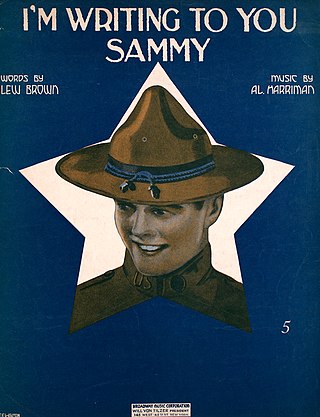
I'm Writing to You, Sammy is a World War I era song released in 1917. Lew Brown wrote the lyrics. Al Harriman composed the music. The song was published by Broadway Music Company of New York, New York. On the cover of the sheet music is a drawing of a soldier, from the shoulders up, inside of a star. Artist E.E. Walton designed the cover. The song was written for both piano and voice.

"My Sweetheart Is Somewhere in France" is a World War I era song first released in 1917. Mary Earl composed the music and wrote the lyrics. Shapiro, Bernstein & Co. Inc. of New York City published the song. Elizabeth Spencer performed a version of the song that was released by the Victor record label.

"Gee! What a Wonderful Time We'll Have When the Boys Come Home" is a World War I era song released in 1917. Lyrics and music were written by Mary Earl. The song was published by Shapiro, Bernstein & Co. of New York, New York. It was written for both voice and piano. The sheet music cover was designed by artist Albert Wilfred Barbelle. On the cover are soldiers marching down a city street. A skyline is behind them, and the lights spell out, "Welcome Home."
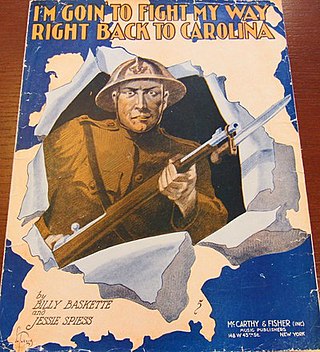
"I'm Goin' To Fight My Way Right Back to Carolina" is a World War I era song written and composed by Billy Baskette and Jessie Spiess. The song was published in 1918 by McCarthy & Fisher, Inc. of New York City. The sheet music cover was designed by Andre C. De Takacs. It features an armed soldier tearing through the cover. The song was written for both voice and piano.

"Lorraine " is a World War I era song released in 1917. Al Bryan wrote the lyrics. Fred Fisher composed the music. It was published by McCarthy and Fisher, Inc.. André De Takacs designed the sheet music cover. It features a French soldier with his bayonet drawn in the foreground. A woman, who is a symbol of Liberty, and child look on behind him. The song was written for voice and piano.
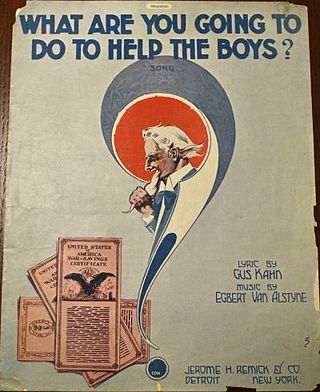
"What Are You Going to Do to Help the Boys?" is a World War I era song released in 1918. Gus Kahn wrote the lyrics. Egbert Van Alstyne composed the music. It was published by Jerome H. Remick & Co. of Detroit, Michigan. Artist E.E. Walton designed the sheet music cover. It features Uncle Sam inside a red, white, and blue question mark. He is holding his beard and looking down at liberty bonds. To the left of this image it reads, "Buy a Liberty Bond!" on some editions. The song was written for both piano and voice.

"Somewhere in France Is Daddy" is a World War I era song released in 1917. Lyrics and music were written by "Great Howard," otherwise known as Howard Miller. It was published by Howard & LaVar Music Co. of New York, New York. There are two versions of the sheet music cover. Both feature a mother holding a child, soldiers firing from a trench, and an inset photo of Great Howard. The latter version is a darker blue and the photo is of Howard in kilts. The song was written for both voice and piano.

"Tom, Dick and Harry and Jack " is a World War I era song released in 1917. Howard Johnson wrote the lyrics. Milton Ager composed the music. The song was published by Leo Feist, Inc. of New York City. Artist Henry Hutt designed the sheet music cover. It features four men in different service uniforms with an inset photo of either Jack Connors, Jr. or Bailey and Cowan. The inset photo varies by edition. It was written for both voice and piano.

"Say a Prayer for the Boys "Out There"" is a World War I era song released in 1917. Bernie Grossman wrote the lyrics. Alex Marr composed the music. It was published by Joe Morris Music, Co. of New York, New York. The sheet music cover was designed by the Starmer Brothers. It features a family praying at the dinner table. Behind them is a sentry guarding a campground of tents. There is an inset photo on the left side that varies per edition. The song was written for both voice and piano.

"Bring Back My Daddy To Me" is a World War I era song released in 1917. William Tracey and Howard Johnson wrote the lyrics. George W. Meyer composed the music. Leo Feist, Inc. of New York, New York published the song.
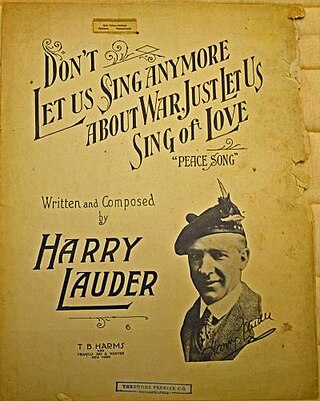
"Don't Let Us Sing Anymore About War, Just Let Us Sing of Love " is a World War I era song released in 1918. Lyrics and music were written by Harry Lauder. It was published by T.B. Harms and Francis, Day & Hunter, Music Co. of New York, New York. The sheet music cover features a photo of Lauder with his autograph. The song was written for both voice and piano.
"Lafayette " is a World War I song written and composed by Mary Earl, which was a pseudonym of Robert A. King. It was published in New York, New York by Shapiro, Bernstein, & Co. in 1918. The sheet music cover, illustrated by Albert Barbelle, depicts soldiers marching with fixed bayonets below a statue of Lafayette in silhouette.

Don't Cry Frenchy, Don't Cry is a 1919 song written during World War I. The lyrics were written by Sam M. Lewis and Joe Young, and the music was written by Walter Donaldson.The song was published by Waterson, Berlin & Snyder Company in New York City.
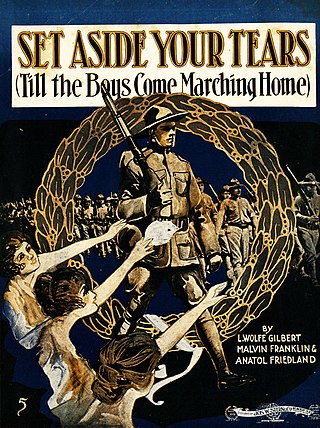
Set Aside Your Tears (Till the Boys Come Marching Home) is a World War I song written and composed by Wolfe Gilbert, Malvin Franklin, and Anatole Friedland. The song was first published in 1917 by Jos. W. Stern & Co. in New York, NY. The sheet music cover depicts a woman waving to marching troops.

Let's All Be Americans Now is a World War I song written and composed by Irving Berlin, Edgar Leslie, and George W. Meyer. The song was first published in 1917 by Waterson, Berlin & Snyder Co., in New York, NY, appearing in the Broadway musical, 'Dance and Grow Thin'. The sheet music cover depicts a soldier with his rifle and silhouetted marching soldiers in the background. A popular recording in 1917 was made by the American Quartet.
"Welcome Home" is a World War I song written by Bud Green and composed by Edward G. Nelson. The song was first published in 1918 by A.J. Stasny Music Co., in New York, NY. The sheet music cover depicts soldiers being welcomed home by men and women.
References
- ↑ Vogel, Frederick G. (1995). World War I Songs: A History and Dictionary of Popular American Patriotic Tunes, with over 300 Complete Lyrics. Jefferson: McFarland and Company, Inc. p. 239. ISBN 0-89950-952-5.
- ↑ Parker, Bernard (2007). World War I Sheet Music. Jefferson: McFarland and Company, Inc. p. 603. ISBN 978-0-7864-2799-4.
- ↑ "Someday They're Coming Home Again". loc.gov. Retrieved 12 February 2015.